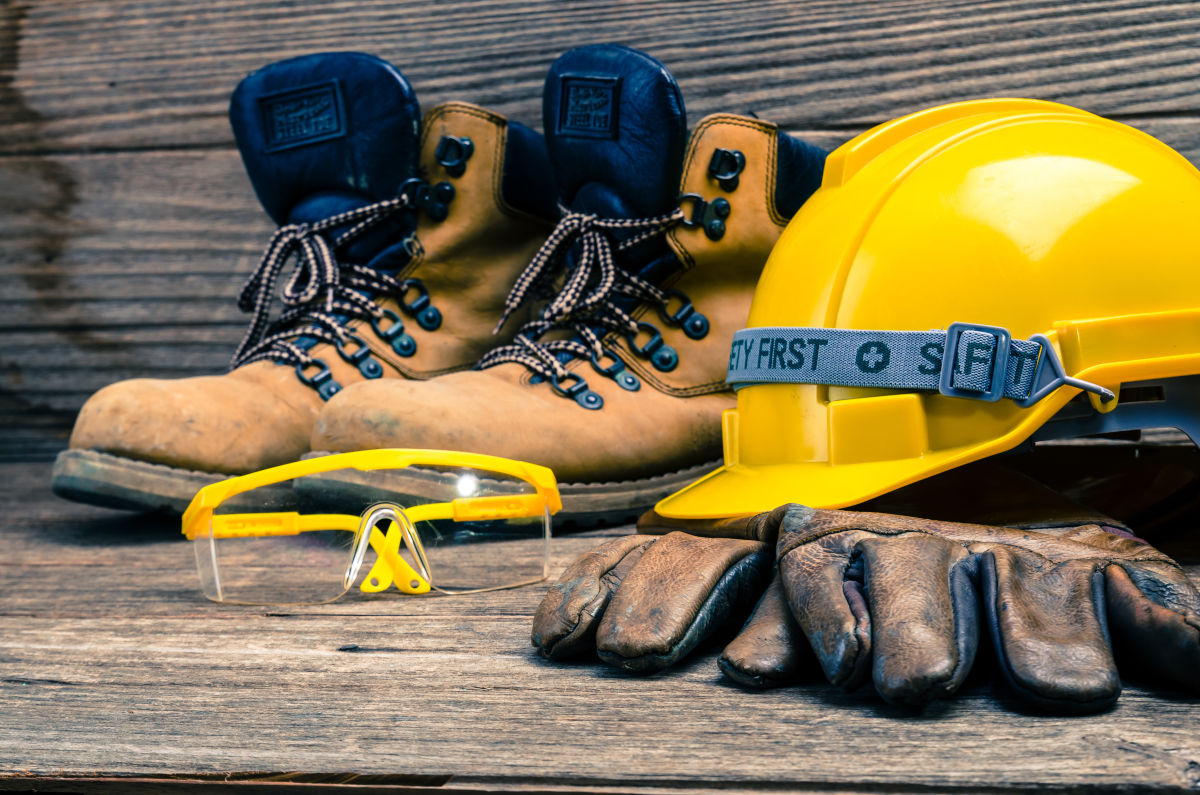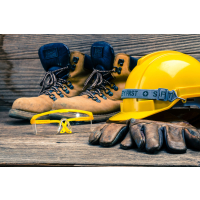- Home
- Blog
- Safety & PPE
- Top 8 Must Have PPE Gear for Your DIY Projects
Top 8 Must Have PPE Gear for Your DIY Projects

Every DIYer soon learns that building up a good toolkit is a great investment. The best way to tackle any job is with equipment designed for proper use. What’s often overlooked however, is vital safety measures, and that includes having the right PPE gear.
Every DIYer soon learns that building up a good toolkit is a great investment. The best way to tackle any job is with equipment designed for proper use. What’s often overlooked however, is vital safety measures, and that includes having the right PPE gear.
From protective clothing to eye protection, PPE equipment will minimise risk and keep you working at your best, so that you can continue to take part in the exciting world of DIY. No matter if it’s your first attempt at home improvements or you’re a regular handyman, there is a recommended PPE.
So, aside from practising good hand hygiene when working, here are the top 8 items to help keep you safe, well and comfortable.
What is PPE?
First of all, what is ppe, and what does ppe stand for? PPE means personal protective equipment. It refers to protective clothing and accessories worn by individuals to protect themselves and others in hazardous environments. It refers to items such as safety glasses, hard hats and gloves.
The term is commonly associated with health care settings. Health workers use personal protective equipment including surgical masks and face shields to protect themselves and to protect patients. The gear prevents close contact with patients, bodily fluid and illness, and offers respiratory protection.
However, there is specific ppe designed for use in other industries like construction, manufacturing, and the oil and gas industry. While pottering on with odd jobs in your own home, the importance of personal safety is frequently ignored. But safety equipment is essential, even around the house.
Top 8 Must Have PPE Items
There are lots of items available for workers, but let’s focus on the gear required for the avid DIYer. When purchasing, you should check that the product meets the Australian standards and regulations for PPE equipment.
Eye Protection
Eyewear is vital for a number of jobs, from small improvements to more ambitious projects. Eye equipment comes as safety glasses or goggles, usually made from polycarbonate.They serve as a shield, and prevent splashes and other foreign objects from entering your eyes. From carpentry work to gardening, safety goggles protect from dust, debris and chemicals in the air during tasks.
There are lots of styles available, and they’re relatively inexpensive too. It’s useful to keep a couple of pairs in the house in case you misplace them.
Hearing Protection
Protecting your hearing is just as important as taking care of your vision. Ear protection includes ear muffs and earplugs. Both are designed to reduce noise exposure to your ears. Loud noises from equipment like power tools can damage the inner ear, and lead to hearing loss.
Ear muffs tend to offer better protection, while earplugs and ear pods are a good choice if you want something a little more discreet.
Safety Gloves
PPE safety gloves are every handyman’s go-to. There’s so many areas that can expose your hands to harm, especially where there is likely to be friction or general irritation. From holding a shovel for long periods of time to handling rubbish, a good pair of safety gloves will keep your hands in one piece.
Rigger gloves are a good place to start. They’re not only used in the workplace, many people slip on a pair at home for maximum protection.
Headwear
Your head is perhaps the most important part of your body to keep out of danger. You should always ensure your head is protected to avoid serious injury. PPE headwear isn’t just for workers on building sites. Wearing hard hats or a helmet while carrying out DIY work will prevent injury should anything hit you.
Hard hats have different requirements, and can protect from hazards like falling objects, debris, and in some cases electric shocks. Consider proper headgear for jobs like cutting trees, working with swinging cables or any other situation where there may be flying or falling objects.
Respirators and Masks
Respirators and masks aren’t only for healthcare workers. When carrying out home improvements, dust and other particles become present in the air. Masks cover the mouth and nose, keeping you from breathing in airborne particles which can be toxic if inhaled. In these circumstances, the face covering will reduce risk of lung damage.
Dust masks keep dust from entering your lungs, and are a good option for work at home. They are suitable for non-toxic exposure, such as gardening jobs, clearing out old furniture and general dusting.
A respirator is a different type of mask. Respirator masks protect the wearer from breathing in harmful particles in the air, like fumes, vapours and gases. From cotton face masks to disposable surgical masks, it’s important to use the right kind in particular scenarios. Having a variety will allow you to switch when alternating tasks.
Knee Pads
Any jobs that require you to kneel down will benefit from knee pads. It’s only a matter of time before your knees become sore when performing tasks like fixing problems under the sink, laying flooring or fitting carpet. Knee pads offer a protective layer for the joint, allowing you to spend long periods of time on your knees when necessary. They’re not restrictive either, you can still move around, and stand up and down with ease.
Painful knees bring numerous problems. As knee pads are inexpensive, ensure you invest in a pair before beginning certain work at home.
Back Support
Wearing a back support might seem over-cautious, but pulling your back out will immediately bring your DIY plans to a halt. Back supports are great for any physical work, including heavy lifting, repetitive jobs and consistent bending.
Your lower back muscles can easily succumb to the strain of manual labour. Get yourself a comfortable back support and you’ll be able to continue hard at work without worrying about back injuries.
Protective Clothing
Protective clothing in your toolkit never goes amiss. It’s important to note that there are many forms of PPE clothing, some of which are unnecessary for home DIY.
In some cases, safety clothes could simply mean throwing on a pair of paint-stained jeans for decorating the house, or wearing an old t-shirt to protect your best garments when handling bleach.
For more intensive jobs, disposable coveralls can be purchased. Coveralls offer full body protection, and are designed with specific safety features, such as flame resistant and chemical resistant materials.
Safety shoes and boots are another good item to have around the house. Safety shoes protect your feet from heat, chemicals, heavy objects and many other hazards. They’ll also keep you from slipping in bad weather or when working on wet surfaces. Just remember to check they fit properly.
Summary
The above list is not exhaustive, but the 8 PPE examples discussed are essential to any person taking on home maintenance projects. It doesn’t matter if you’re new to the experience or consider yourself a pro, there’s no denying the importance of ppe safety and a risk management strategy.
Cut the excuses and build up a reliable DIY kit of protective gear to go alongside your toolbox. You never know what hazards await you down the line as you get stuck into your project. Having the right equipment at hand will save effort, time and minimise risk.
When purchasing PPE, remember to always check Australian standards and regulations to ensure you only buy the most appropriate equipment designed for true protection. If unsure of what to go for, you can always seek further advice and guidance online or contact the manufacturers.
FAQs
What is PPE gear?
The meaning of PPE is personal protective equipment. Personal protective equipment gear refers to the clothing and equipment required for certain jobs. Items include eyewear, ear protection, headwear, safety gloves and masks, among others.
What is PPE gear used for?
Personal protective equipment or PPE is required in situations where there are hazards present. This could include exposure to dangerous airborne particles, contact with chemicals, electricity and many other workplace hazards. The PPE gear prevents injury to the wearer.
Do I need to wear PPE for DIY?
Many DIY projects require personal protective equipment (PPE) to keep the wearer safe. From using power tools to handling harmful cleaning agents, the right protective clothing and gear is essential during any home maintenance where there is danger.


